This was another beautiful spring day! It began
like other classes at the Wise Woman Center, with
the parking, sitting in circle, and sharing with
the talking stick. The group was smaller this
time. I find I like both large groups, for the
great number of new people to meet and the inputs,
and I like small groups, for their intimacy. They
both have their benefits. And now since I knew
these women from the day before, the group was
even more intimate.
The day before, at the end of class, Susun explained
the differences between nourishing, tonifying,
and sedating/stimulating herbs. This is how I
understand them, though my learning continues
to evolve deeper and more accurate --
Nourishing herbs nourish our body. We can take
them on a daily basis, as we would a nourishing
food, with no ill effects. We could also stop
taking them with no ill effects. The example Susun
offered was to have us hug someone next to us.
That was nourishing. Now we don't need to hug
again for that nourishment and even if we never
hug again the nourishment from that one hug will
always be with us.
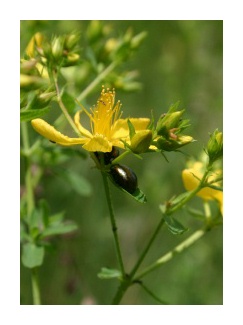 Tonifying
herbs work slowly to tone our body. Again, if
we stop, there should be no ill effect. They are
taken over a period of time, but not necessarily
for the rest of our life. Susun demonstrates with
her hands showing a lower and higher tolerance
for life. With tonifying herbs the difference
between them grows greater offering a stronger
tolerance for life, as compared with the next
category of herbs . . . .
Tonifying
herbs work slowly to tone our body. Again, if
we stop, there should be no ill effect. They are
taken over a period of time, but not necessarily
for the rest of our life. Susun demonstrates with
her hands showing a lower and higher tolerance
for life. With tonifying herbs the difference
between them grows greater offering a stronger
tolerance for life, as compared with the next
category of herbs . . . .
Sedating/stimulating herbs, which Susun shared
can be the same, can bump up or down the pair
of hands, while the distance remains the same
between them. Then when we stop using the stimulating
herb, for example, the upper level moves back
into its original place, decreasing our range
of tolerance for life.
Keep in mind this is all my memory and understanding
at this point and may not be perfectly accurate
in describing these herbs.
I want to share this, though it was from the
class the day before because it helps me understand
an herbal medicine chest (hmc) in relation to
other things we learn. What we would keep in our
medicine chest often falls into the last category
of herbs I described. It would not be the first
category (I believe they belong in our kitchen
cabinets and on our counters).
I took this same class two years ago and have
since made most the creations (on a list we were
given) and used at least once about 60 percent
of them. (It seems these days when something happens
with me, I am a bit excited because I get to experiment
on myself with my newest herbal creations.) In
the last two years I also developed many questions
I got to ask this time, and though I learned tons,
I know next year there will be more questions.
I love that the same class is taught year after
year.
We learned nine main creations to have on hand,
and eight more goodies to add to it. The first
nine I understand to be most valuable to carry
with in a travel bag when away from home. We visited
as many of these herbs in the wild as we could
see so early in the season. This was all before
another incredible lunch.
This lunch's wild greens were again garlic mustard
leaves and tops of madder, but also wild chives
(chopped very fine) and a few rock cress leaves
(a small mustard plant blooming tiny white flowers
right now). The soup was of root vegetables and
seaweed with ginseng and another root ( I don't
remember) infused in a separate bag so they could
be removed as they are too tough for eating. All
this, like the previous day's nettle soup, was
prepared (at least) a day before and allowed to
infuse until our lunchtime.
We had some new vinegars this time -- one was
shitake from the stems left over when using the
mushrooms to cook (soaking them in vinegar left
them soft enough to eat as well). On one of these
two days we also were offered garlic mustard root
vinegar. I like that even during lunch, I not
only get a yummy very nourishing meal, I still
get to keep learning! Oh yes, during lunch we
also got to sample dandelion wine. This was important
to me because I made a batch the previous year
and, not ever having tasted it before, wasn't
sure if I had done it correctly. Unfortunately
I concluded I hadn't, and plan to try again this
year.
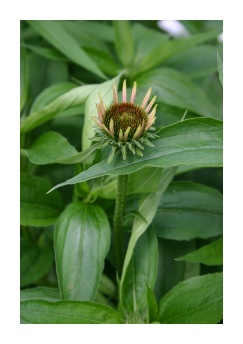 After
lunch, we all stayed on the porch and Susun brought
out a collection of all the herb concoctions we
had been talking about so we could see, smell
and taste. I love this hands on learning. It is
one thing for me to follow directions in a book,
but a whole other thing to see the finished product
done properly. And though I thought myself pretty
skilled at preparing tinctures, oils, vinegars
(and wines), I still learned how to improve upon
myself.
After
lunch, we all stayed on the porch and Susun brought
out a collection of all the herb concoctions we
had been talking about so we could see, smell
and taste. I love this hands on learning. It is
one thing for me to follow directions in a book,
but a whole other thing to see the finished product
done properly. And though I thought myself pretty
skilled at preparing tinctures, oils, vinegars
(and wines), I still learned how to improve upon
myself.
Here are some of the herbs we learned:
First I must mention Echinacea tincture. It is
my gold. I always have lots ready so I never have
to curb our amounts and so I can freely hand out
bottles to family and friends. One thing I learned
is, though I can start using it after 6 weeks,
it will improve if left to infuse in the vodka
longer, up to a year in fact. Neat and tidy me
had been decanting it after six weeks though I
had already been told that wasn't necessary. I
learned if using the fresh root it must be a minimum
of three years old.
I also learned a use for the mass that is left
over after decanting. That is to pour boiling
water over it and store it in the fridge for up
to three months. I never like wasting anything,
so this was great. Susun also suggested those
with a centrifugal juicer to remove the blade
and run the spent root in it to get the last bit
of tincture out of it. Echinacea is used for bacterial
infection. It increases the white blood cells
in our body (I think I remember her saying). A
sign for this infection is heat, redness, and
pain. I found it important to remember the heat
doesn't need to be fever, but local.
Another gift for our travel bag is motherwort
tincture. We got to see this plant just coming
out of the ground a couple inches high. I have
loved this plant for myself during my bleeding
times when I am crampy. Since I started using
it I find I need less and less each month, and
sometimes none. I hear it is also used for when
we are upset about "what could have happened".
I have not needed osha root tincture, but I think
it sounds a comforting thing to have for when
there is a strong allergic reaction to relieve
the swelling. I learned it could also be used
for my son for his huge mosquito bites he gets,
even though this of course isn't life threatening.
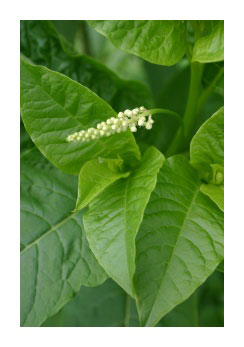 As
Susun put these things in bottles for the apprentices'
medicine bags, she used a "memory device"
that I liked. She only halfway filled the bottles
of tinctures that one would only need in small
doses, like the osha root, poke root , and wormwood.
As
Susun put these things in bottles for the apprentices'
medicine bags, she used a "memory device"
that I liked. She only halfway filled the bottles
of tinctures that one would only need in small
doses, like the osha root, poke root , and wormwood.
Poke wasn't coming out of the ground yet, but
we got to visit where it lived in her garden and
see the dried tall stalk from its last year berries.
I wish I could relay even half of what I learned
in this class, but this post would be too long
(if it isn't already). So with each herb I feel
I am leaving out so much.
In the case of poke there were a couple stories
Susun told that has helped me remember the need
for SMALL doses with this plant. Unfortunately,
I think they would lose something if written by
me. I really do love learning by story.
Skullcap is an herb I learned about 2 years ago
and again this year. I have yet to find it, prepare
a tincture of it, or use it. It sounds valuable
to have around to use in small amounts for pain
or headache. This year I got to see the seed capsules
pulled out of the tincture, which is more helpful
to me than pictures in a book. I will search again
this year!
St. Joan's wort is an herb we can use both as
a tincture and as an oil. Both of which I have
made and begun experimenting with. Susun explained,
as she has done before, why she calls hypericum
perforatum, St.Joan's instead of St. Johns, yet
I cannot remember it to share with you (or anyone
else who has asked). I have heard her explanation,
it makes sense to me, so I have chosen to call
it St. Joan's wort, and forgotten the explanation
as it was not needed by me after making my choice!
I can be silly that way.
One thing I like to share when people ask about
the claims of this tincture to cure depression,
is that the bright yellow flowers are collected
at summer solstice (silly it's called the first
day of summer I think) and infused in vodka making
it essentially sunshine in a bottle. This means
it will help people who have what I call the midwinter
blues (sometimes called SAD - seasonal affective
disorder), by bringing them a little summer sun.
Susun then adds something like "if you are
in a shitty abusive marriage, it won't do a thing!"
For those of you who have never used this plant
before, it turns your oil and vodka red! All I
have to do is look at a bottle of the red tincture
and instantly flash to the warm bright midsummer
day among these thigh high plants (that I personally
find beautiful all season long), and I get a break
from the winter blues.
So on to wormwood tincture. Again this is something
I have not had occasion to use, but it sounds
valuable, so last year I bought it premade AND
two baby plants to begin growing in my garden.
I much prefer my own creations, but am willing
to buy to tie me over. I hear it is used for digestive
upset -- in tiny amounts. Thankfully and not so
thankfully I personally have not had use to experiment
with this yet. Though I KNOW of Susun's great
knowledge I love to have personal experience to
speak from. Besides, there may be 2 or more different
herbal preparations for the same complaint, yet
on experimentation I can find that there are different
kinds of digestive upset, for example, and each
herb works differently. This is where I find Susun's
stories helpful. Since we often don't have more
than one word for stomachache or headache, etc.,
a story can help describe a difference.
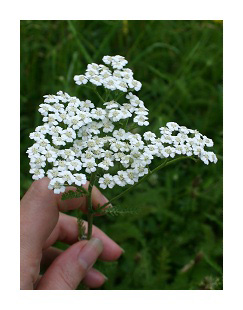 Yarrow,
yarrow. A weed I am told by neighbors, and a beautiful
plant to me. Last year I experimented with creations
with it, making a vinegar, tincture, and oil.
I have yet to use them. During this class, Susun
showed me I could put it in a spray bottle and
use it regularly to keep mosquitoes from biting.
Yay, for me and my son. I think she also mentioned
it can deter ticks. Yay again for a mom of a young-un
who lives in the woods.
Yarrow,
yarrow. A weed I am told by neighbors, and a beautiful
plant to me. Last year I experimented with creations
with it, making a vinegar, tincture, and oil.
I have yet to use them. During this class, Susun
showed me I could put it in a spray bottle and
use it regularly to keep mosquitoes from biting.
Yay, for me and my son. I think she also mentioned
it can deter ticks. Yay again for a mom of a young-un
who lives in the woods.
I am also understanding this tincture to be
useful for infections as I heard in this class
and from some articles I have read on the SusunWeed
website. I want to know more about this, the difference
between this and echinacea -- the questions for
next year are piling up already. Of course, I
could have asked this Sunday, but I already have
much to assimilate.
Beyond these nine herb creations I plan to put
together for my travel/always-on-hand bag, Susun
also discussed the use of some other preparations.
These are burdock root tincture and vinegar, dandelion
tincture and vinegar, mullein leaf infusion, plantain
leaf oil, chasteberry tincture and wintergreen
leaves. I missed the last four because I went
down to the road to pick up my son being dropped
off by my hubbie on his way to work. We got to
see baby burdock plants growing and learned they
are biennial. We even got to sample the cut up
root after it had soaked in the vinegar. Yum,
it still had that sweet earthiness I love. I understand
this root to be a wonderful ally for skin. I want
to experiment more with it on someone.
Dandelion seems pretty magnificent to hear Susun
talk. I made tincture and vinegar of it to give
to my father dealing with liver problems. I haven't
used it myself yet, but am curious to see if,
taken with my meals, it will help my digestion
(as I have discovered fermented foods do). Something
on plantain oil I remember form two years ago
is it stinks (to me anyway). I thought I made
a bad batch until I got to smell one made at the
Wise Woman Center and realized this is just how
it is. Also, for saving stained clothes it seems
best to make this oil into an ointment. Some other
things I remember in passing is strain mullein
leaf infusion to remove hairs, glycerine is not
a substitute for vodka, and is NOT a tincture,
it may be preferable to take aspirin than willow
or wintergreen who have no measured amounts of
the similar compound.
A lot of information for one day. I started trying
to take notes at one point, then realized I wasn't
hearing the same, so I quickly put away my pen
and paper.
After these two classes I am anxious to collect
birch twigs for brew, make pine needle, hemlock
(a new one for me), and cronewort vinegars, experiment
with my dandelion tincture and vinegar, and eat
more wild salads!
Thanks again for listening. I hope you enjoyed.
I plan to take all Susun's one-day workshops at
the Wise Woman Center this year and plan to tell
you all about them (at least my experience of
them)!!
Herbal Medicine Chest
by Karen Joy
great green blessings to you all
live-out apprentice to Susun Weed
member of Wise Woman Web team
For permission to reprint this article,
contact us at: susunweed@herbshealing.com
My Herbal Medicine Chest
3 CD set
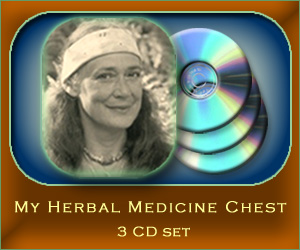 Susun Weed. Green Nations Gathering 1998.
Susun Weed. Green Nations Gathering 1998.
Here are the remedies I never leave home without. How I use them and why I use them. Includes specific information on echinacea, poke root, motherwort, skullcap, St. Joan's wort, wormwood, plantain, and more.
Price: $30
Order My Herbal Medicine Chest in our Bookshop






 Study
with Susun Weed in the convenience of your home! Choose from
four Correspondence Courses: Green Allies, Spirit & Practice
of the Wise Woman Tradition, Green Witch, and
Study
with Susun Weed in the convenience of your home! Choose from
four Correspondence Courses: Green Allies, Spirit & Practice
of the Wise Woman Tradition, Green Witch, and 